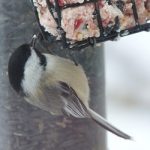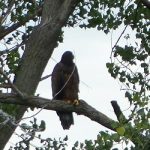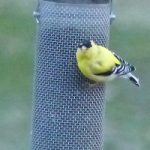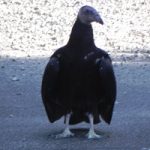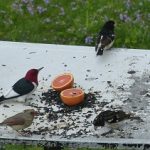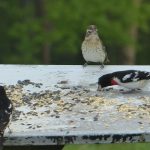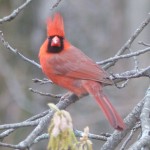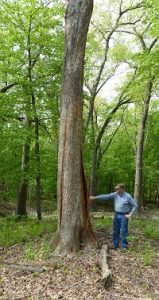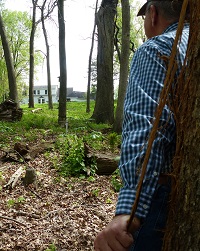Keeping A Bird List
A joy of inviting beautiful wildlife to a yard is the periodic chance to see something new. That happened recently at Winding Pathways. We were astonished to spot a Black Poll warbler in our oaks. It was the first of this species we’d ever seen anywhere. Another amazing sight happened on a clear March morning when sounds from above brought us outside. We were thrilled to watch a huge flight of snow geese winging north way over our house.
- In all seasons chickadees forage and sing.
- Fledgling eagle resting in the back yard.
- Enjoying the thistle seed.
- A turkey vulture ventured into the labyrinth.
- Three species sharing the bounty
- With brilliant plumage and distinctive call, the grosbeaks announce their arrival.
- Photo – On a wild and windy day this Cardinal sang out his love song.
We’re not overly serious birders, but keep a running tally of species spotted each year. Lists are fun, especially for people with a competitive bent. We identify birds by either sight or sound, and use these clues in our count of yard visitors. We also include some species that fly over but don’t land. Winding Pathways is two acres. And, we’re fortunate. Just past our property line is 110 acre Faulke’s Heritage Woods. Its large oaks and elms attract forest birds that might not normally visit our yard.
Here’s our running tally this year as of mid-May:
Wild Turkey
Seven woodpecker species (Hairy, downy, red bellied, red headed, sapsucker, pileated, and flicker)
House Finch
English Sparrow
Junco
European Starling
Native sparrows (white crowned, white throated, song, fox, chipping)
Indigo bunting
Warblers (black polled, yellow rump, yellow, palm, and redstart)
Oriole, orchard and northern (Baltimore)
Cardinal
Tufted Titmouse
Black Capped Chickadee
Hummingbird
Wren (house and Carolina)
Goose (snow and Canada flying over)
Ducks (mallard and wood)
Owl (barred and great horned)
Hawk (Coopers, sharp shinned, red tailed)
Turkey vulture
Chimney Swift
Nighthawk
Brown Creeper
Cuckoo
Goldfinch
Robin
Crow
Killdeer
Whip-poor-will
Mourning Dove
Bald eagles
As we continue to add a diversity of shrubs, trees, grasses, and wildflowers we’re creating habitats that should lure new species to our yard. We’ll keep adding species as the year goes on.
We use several references to help identify birds. Here are our favorites:
Printed books. Real bird books:
The Peterson Field Guide to Birds of North America. This 2008 book is fairly large and heavy, we keep it in the house to aid in identification.
The Golden Guide to Field Identification. Birds of North America. This classic bird book has been around for years. It’s small and easy to carry and is the book that stays in the car and gets carried when we’re walking a trail seeking birds.
The Sibley Guide to Bird Life and Behavior. This details the life history of birds. It’s a heavy large reference book that provides information on a bird once we’ve used other sources to make an identification. A companion Sibley book helps with identification.
Electronic Identification Aids
Outstanding information sources come from the Cornell University Laboratory of Ornithology, both on their website and on their smart phone app called Merlin. We use Merlin regularly when in the field. Although it lacks some species our iPhone is easy to carry and the organization of the app makes it easy to identify a new species. The app includes several still photos of each bird, range maps, and the call and song of the bird. It’s Free!
When at home we often access the Lab’s Website. It includes more extensive information on more species than the iPhone app and has video clips. It is outstanding, and access is also free. We like it so much we joined the Lab and appreciate receiving its gorgeous and informative magazine called LIVING BIRD. The Lab’s general web address.

